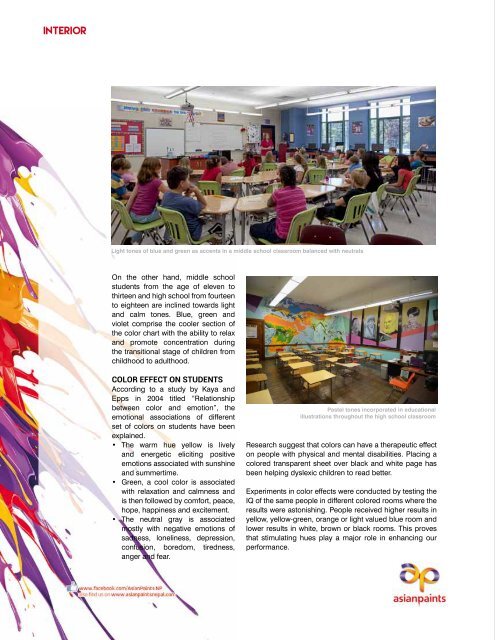SPACES feb issue 2017
Create successful ePaper yourself
Turn your PDF publications into a flip-book with our unique Google optimized e-Paper software.
Interior<br />
Light tones of blue and green as accents in a middle school classroom balanced with neutrals<br />
On the other hand, middle school<br />
students from the age of eleven to<br />
thirteen and high school from fourteen<br />
to eighteen are inclined towards light<br />
and calm tones. Blue, green and<br />
violet comprise the cooler section of<br />
the color chart with the ability to relax<br />
and promote concentration during<br />
the transitional stage of children from<br />
childhood to adulthood.<br />
COLOR EFFECT ON STUDENTS<br />
According to a study by Kaya and<br />
Epps in 2004 titled “Relationship<br />
between color and emotion”, the<br />
emotional associations of different<br />
set of colors on students have been<br />
explained.<br />
• The warm hue yellow is lively<br />
and energetic eliciting positive<br />
emotions associated with sunshine<br />
and summertime.<br />
• Green, a cool color is associated<br />
with relaxation and calmness and<br />
is then followed by comfort, peace,<br />
hope, happiness and excitement.<br />
• The neutral gray is associated<br />
mostly with negative emotions of<br />
sadness, loneliness, depression,<br />
confusion, boredom, tiredness,<br />
anger and fear.<br />
Pastel tones incorporated in educational<br />
illustrations throughout the high school classroom<br />
Research suggest that colors can have a therapeutic effect<br />
on people with physical and mental disabilities. Placing a<br />
colored transparent sheet over black and white page has<br />
been helping dyslexic children to read better.<br />
Experiments in color effects were conducted by testing the<br />
IQ of the same people in different colored rooms where the<br />
results were astonishing. People received higher results in<br />
yellow, yellow-green, orange or light valued blue room and<br />
lower results in white, brown or black rooms. This proves<br />
that stimulating hues play a major role in enhancing our<br />
performance.<br />
68 / <strong>SPACES</strong> February <strong>2017</strong>


















